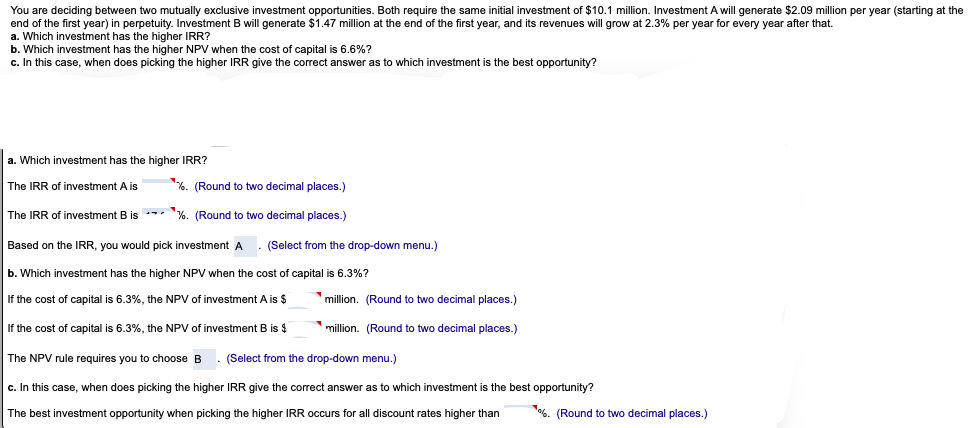You are deciding between two mutually exclusive investment opportunities. Both require the same initial investment of $10.1 million. Investment A will generate $2.09 million per year (starting at the end of the first year) in perpetuity. Investment B will generate $1.47 million at the end of the first year, and its revenues will grow at 2.3% per year for every year after that. a. Which investment has the higher IRR? b. Which investment has the higher NPV when the cost of capital is 6.6%? c. In this case, when does picking the higher IRR give the correct answer as to which investment is the best opportunity? a. Which investment has the higher IRR? The IRR of investment A is %. (Round to two decimal places.) The IRR of investment B is %. (Round to two decimal places.) Based on the IRR, you would pick investment A (Select from the drop-down menu.) b. Which investment has the higher NPV when the cost of capital is 6.3%? If the cost of capital is 6.3%, the NPV of investment A is $ If the cost of capital is 6.3% , the NPV of investment B is $ The NPV rule requires you to choose B million. (Round to two decimal places.) million. (Round to two decimal places.) (Select from the drop-down menu.)
You are deciding between two mutually exclusive investment opportunities. Both require the same initial investment of $10.1 million. Investment A will generate $2.09 million per year (starting at the end of the first year) in perpetuity. Investment B will generate $1.47 million at the end of the first year, and its revenues will grow at 2.3% per year for every year after that. a. Which investment has the higher IRR? b. Which investment has the higher NPV when the cost of capital is 6.6%? c. In this case, when does picking the higher IRR give the correct answer as to which investment is the best opportunity? a. Which investment has the higher IRR? The IRR of investment A is %. (Round to two decimal places.) The IRR of investment B is %. (Round to two decimal places.) Based on the IRR, you would pick investment A (Select from the drop-down menu.) b. Which investment has the higher NPV when the cost of capital is 6.3%? If the cost of capital is 6.3%, the NPV of investment A is $ If the cost of capital is 6.3% , the NPV of investment B is $ The NPV rule requires you to choose B million. (Round to two decimal places.) million. (Round to two decimal places.) (Select from the drop-down menu.)
Cornerstones of Cost Management (Cornerstones Series)
4th Edition
ISBN:9781305970663
Author:Don R. Hansen, Maryanne M. Mowen
Publisher:Don R. Hansen, Maryanne M. Mowen
Chapter19: Capital Investment
Section: Chapter Questions
Problem 13E: Buena Vision Clinic is considering an investment that requires an outlay of 600,000 and promises a...
Related questions
Question

Transcribed Image Text:You are deciding between two mutually exclusive investment opportunities. Both require the same initial investment of $10.1 million. Investment A will generate $2.09 million per year (starting at the
end of the first year) in perpetuity. Investment B will generate $1.47 million at the end of the first year, and its revenues will grow at 2.3% per year for every year after that.
a. Which investment has the higher IRR?
b. Which investment has the higher NPV when the cost of capital is 6.6%?
c. In this case, when does picking the higher IRR give the correct answer as to which investment is the best opportunity?
a. Which investment has the higher IRR?
The IRR of investment A is
%. (Round to two decimal places.)
The IRR of investment B is %. (Round to two decimal places.)
Based on the IRR, you would pick investment A (Select from the drop-down menu.)
b. Which investment has the higher NPV when the cost of capital is 6.3%?
If the cost of capital is 6.3%, the NPV of investment A is $
million. (Round to two decimal places.)
If the cost of capital is 6.3%, the NPV of investment B is $
million. (Round to two decimal places.)
The NPV rule requires you to choose B
(Select from the drop-down menu.)
c. In this case, when does picking the higher IRR give the correct answer as to which investment is the best opportunity?
The best investment opportunity when picking the higher IRR occurs for all discount rates higher than
%. (Round to two decimal places.)
Expert Solution
This question has been solved!
Explore an expertly crafted, step-by-step solution for a thorough understanding of key concepts.
This is a popular solution!
Trending now
This is a popular solution!
Step by step
Solved in 2 steps with 2 images

Knowledge Booster
Learn more about
Need a deep-dive on the concept behind this application? Look no further. Learn more about this topic, finance and related others by exploring similar questions and additional content below.Recommended textbooks for you

Cornerstones of Cost Management (Cornerstones Ser…
Accounting
ISBN:
9781305970663
Author:
Don R. Hansen, Maryanne M. Mowen
Publisher:
Cengage Learning

Intermediate Financial Management (MindTap Course…
Finance
ISBN:
9781337395083
Author:
Eugene F. Brigham, Phillip R. Daves
Publisher:
Cengage Learning

EBK CONTEMPORARY FINANCIAL MANAGEMENT
Finance
ISBN:
9781337514835
Author:
MOYER
Publisher:
CENGAGE LEARNING - CONSIGNMENT

Cornerstones of Cost Management (Cornerstones Ser…
Accounting
ISBN:
9781305970663
Author:
Don R. Hansen, Maryanne M. Mowen
Publisher:
Cengage Learning

Intermediate Financial Management (MindTap Course…
Finance
ISBN:
9781337395083
Author:
Eugene F. Brigham, Phillip R. Daves
Publisher:
Cengage Learning

EBK CONTEMPORARY FINANCIAL MANAGEMENT
Finance
ISBN:
9781337514835
Author:
MOYER
Publisher:
CENGAGE LEARNING - CONSIGNMENT

Financial And Managerial Accounting
Accounting
ISBN:
9781337902663
Author:
WARREN, Carl S.
Publisher:
Cengage Learning,

Managerial Accounting
Accounting
ISBN:
9781337912020
Author:
Carl Warren, Ph.d. Cma William B. Tayler
Publisher:
South-Western College Pub

Principles of Accounting Volume 2
Accounting
ISBN:
9781947172609
Author:
OpenStax
Publisher:
OpenStax College